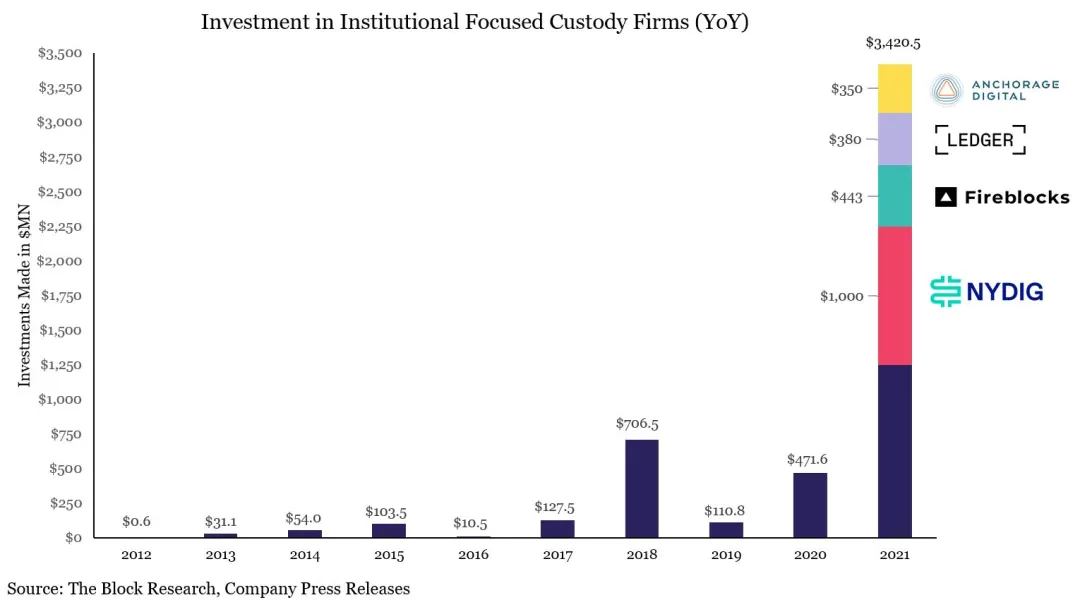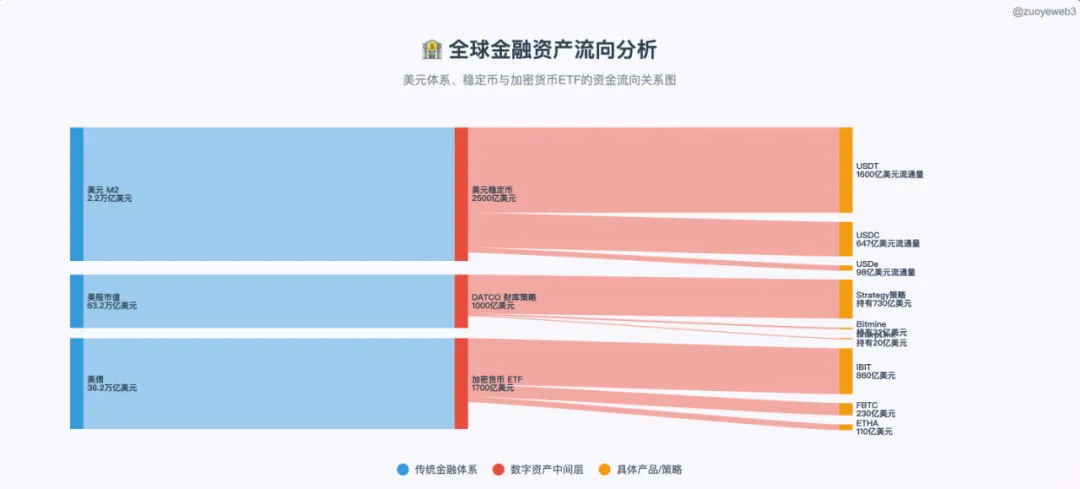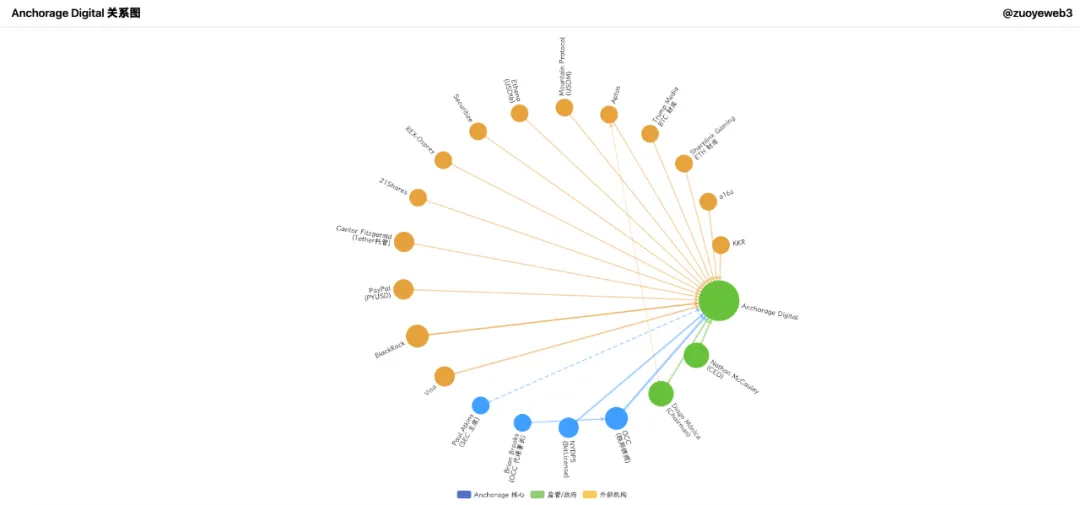Custody Crypto: Anchorage's Iron Vault, Starship Troopers' Iron Throne
After more than a decade of crypto frenzy, the wealth creation movement driven by Bitcoin's halving every four years has come to an end. What follows is intermittent liquidity from U.S. stocks, the dollar, and U.S. Treasuries, with discrete hotspots linking each cycle, much like Pendle's journey from fixed income, LST, BTCFi to Ethena and Boros.
The difficulty of becoming new money is not comparable to managing old money.
Custody institutions say, whoever has money earns whoever's money.
There are really three types of wealthy individuals in the crypto space: individual whales (early Bitcoin miners, early ETH investors, DeFi Summer OGs), on-chain institutions (crypto-native VCs, CEXs, public chains, and a few project parties), and the new and old giants backed by Wall Street.

Custody institutions have since differentiated. After raising $3 billion in 2021, the basic landscape of crypto custody was established following the collapses of FTX-Celsius and 3AC-Luna-UST in 2022. Examples include:
• Serving on-chain projects Copper/Ceffu/Cobo
• Serving ETFs Coinbase
• Bank-level BNY (Bank of New York Mellon)
• Exchange Fireblock
Especially Coinbase, which has almost captured all ETF custody shares, with over 80% of BTC and ETH ETF issuers choosing to collaborate with it. In treasury strategies, MSTR also prefers Coinbase for BTC custody.
The end of the retail trading era and the arrival of the institutional wealth management era
The ways to make money in the crypto space have evolved with the times. Under the scale effect of capital, whoever has the most money can take the most profit. From miners, exchanges, market makers, the next will be custody institutions, especially as traditional financial capital moves on-chain, it will not be directly placed on public chains and exchanges, but will be transferred through custody institutions.
Ethereum's daily trading volume has surpassed the peak of DeFi Summer, reaching 1.74 million transactions. However, the current growth driver is not activities like memes or trading, but the stablecoin circular lending ignited by Aave and Ethena.
Coincidentally, Aave and Plasma are collaborating on stablecoins moving on-chain for traditional finance. Under the Genius Act restrictions, payment stablecoins cannot pay interest to users, and once funds are deposited on-chain, they will have nowhere to go, becoming a dead weight for issuers.
On the other hand, as the overall trading volume of CEXs continues to shrink, developing non-trading custody, staking, and yield will become a new business model that banks and other TradFi are eyeing, especially under the expectation of interest rate cuts. How to channel liquidity represented by 401(k)s and treasury strategies onto the chain will become a new entrepreneurial opportunity.
The exchange cycle is nearing its end, with on-chain and IPO pressures, Hyperliquid shows signs of flipping Binance, while exchanges like Kraken and Bullish challenge Coinbase's status as the only listed exchange.
Overall, everyone is focused on the post-CEX era's yield dividends. For old money with massive capital, the APR can be lower, but the principal must be sufficiently safe. Tether has built a physical vault for its own gold, and on-chain vaults are also a good business.
Under the dominance of ETFs, it is difficult for anyone to shake Coinbase's ruling position. Each generation of versions brings new gods, and the new market landscape also provides new opportunities for second and third-tier players.

Compared to the immense wealth of the dollar, U.S. Treasuries, and U.S. stocks, we are still at the stage of catching it with a basin; only a sufficiently safe bathtub will allow more liquidity to flow seamlessly.
Thus, old players began to differentiate, with Anchorage Digital and Galaxy Digital undoubtedly being the two most representative players.
• Serving treasury (DATCO) Galaxy
• Stablecoin Anchorage
• Emerging ETF staking Anchorage Digital & Galaxy Digital
Outside of BTC and ETF spot ETFs, the two Digitals have a common goal of capturing more market share from Coinbase, and we will start from this common point.
Currently, in the spot ETF market, there are two basic trends: one is generalization, where altcoins and meme coins, apart from BTC and ETH, are expected to directly convert to ETFs after meeting the requirement of being listed on Coinbase derivatives for six months; the second is the approval of staking ETFs, allowing ETF issuers to redeem physical assets, opening interfaces for on-chain staking services.
For example, Anchorage Digital has become the exclusive custodian and staking partner for the REX-Osprey Solana staking ETF, perfectly aligning with the above two points. If the bull market continues, more ETF products will become a focus for Digital's custody efforts.
In traditional ETFs, Anchorage has also secured partnerships with 21Shares and BlackRock. Interestingly, it has also become the custodian for the Bitcoin treasury of the Trump Media Group, which can only be said to be a case of cats having their own ways, as the cold wind of Anchorage has reached Mar-a-Lago.
Anchorage's licensed bank stablecoin layout and the dream of a crypto iron vault
In 2019, Anchorage attempted to collaborate with Visa, and by 2021, it became Visa's USDC settlement agent bank.
In 2021, the crypto custody business started, with a valuation of $3 billion, becoming a crypto bank licensed by the OCC and a digital asset custodian for the U.S. Marshals Service (USMS).
In 2022, during the crypto crash, it became the preferred custodian for Aptos, and Anchorage co-founder Diogo Mónica was also an investor in Aptos.
In 2023, Q1 platform assets grew by 80%, but 75 employees were laid off, accounting for 20%, calling for regulation of stablecoins.
In 2024, co-founder Diogo Mónica exited major business management, with Nathan McCauley taking full responsibility.
In 2025, Anchorage Digital will be responsible for the custody of Trump Media's Bitcoin treasury, acquiring the USDM issuer Mountain Protocol.
Let me formally introduce Anchorage Digital, founded in 2017 by Nathan McCauley and Diogo Mónica. Initially just a small local trust company in South Dakota, a serendipitous event in 2021 made Anchorage Digital the only super lucky entity to receive a crypto bank license from the OCC (Office of the Comptroller of the Currency).
Whether in Silicon Valley, Wall Street, or Washington, providing exclusive financial services ultimately comes down to human relationships.

Image description: Anchorage Digital's network
Image source: @zuoyeweb3
Anchorage Digital has developed various forms of business around institutions, including trading, derivatives, clearing, staking, and custody, which can be understood as a one-stop crypto solution for institutions. Besides traditional crypto asset custody, Anchorage is betting its future on stablecoins, which is also its biggest difference from Galaxy.
Thus, we arrive at the first chapter of the story: the first in entrepreneurship, Timing determines everything.
In 2021, with the Democratic Party taking a strict regulatory stance on cryptocurrencies, President Biden took office. Spending tens of millions of dollars to sponsor Biden, SBF was still looking forward to a crypto spring. At this time, former Coinbase Chief Legal Officer Brian Brooks was appointed as the acting head of the OCC.
During his tenure, Brian maintained a crypto-friendly attitude, promoting banks to open service windows for crypto businesses, launching the REACh (Roundtable for Economic Access and Change) initiative, and encouraging banks to adopt a non-discriminatory attitude towards crypto enterprises.
Anchorage seized the opportunity, leaping from a local trust institution to Anchorage Digital Bank, transforming into a true national bank;
Once again, on January 13, 2021, Anchorage Digital Bank obtained the qualifications to accept U.S. dollar deposits and conduct crypto custody.
The day after, on the 14th, Brian officially resigned, and by a twist of fate, Anchorage Digital became the only licensed crypto bank to date.
Today, you can see the value of this license on almost all pages and product descriptions of Anchorage Digital, which successfully raised a total of $430 million in Series C and D rounds, sustaining itself until the 2025 stablecoin wave.
It is worth mentioning that among the investors, there are both crypto VCs like a16z and Wall Street giants like KKR and BlackRock.
As a side note, Bitpay and Paxos were also applying at that time but did not receive the favor of Lady Luck. Recently, Paxos was fined $26.5 million by the New York DFS for non-compliance regarding BUSD.
Additionally, Anchorage holds both the OCC's federal crypto bank license and New York's Bitlicense, making it second only to BNY in terms of licensed compliance value.
However, after Brian's departure, Anchorage also had conflicts with the OCC, but incredibly, the license remained intact.
The only license, benefiting for a lifetime.
With the support of the license, Anchorage can custody everything, from stablecoin issuance reserves to cryptocurrencies, and even NFT businesses. However, the crypto crash of 2022 also caused Anchorage to gradually become unstable, with the founders' "infighting" being the first to bear the brunt.
Ultimately, Diogo Mónica left to join Hanu Ventures as a partner while retaining the position of Executive Chairman at Anchorage Digital, mainly responsible for recruitment and strategy, while Nathan McCauley took full charge of the main business, starting to strategize for BlackRock's stablecoin business.
Anchorage has become the custodian for 21Shares' Bitcoin and Ethereum spot ETFs, as well as the exclusive custodian and staking partner for the REX-Osprey Solana staking ETF.
However, outside of the ETF business, Anchorage Digital has achieved significant success, especially in stablecoins. It not only collaborates with Visa for stablecoin payments but also introduces compliant stablecoins like PayPal's PYUSD for institutional investors.
Interestingly, Tether's custodian and investor Cantor Fitzgerald has also partnered with Anchorage to provide custody services for Cantor Fitzgerald's Bitcoin business.
As a result, Anchorage Digital has become the custodian of Tether's custodian.
Although it has a license, Anchorage's business was not particularly prominent before 2025. Despite a valuation of $3 billion and $50 billion in assets under management, it faced despair in the ETF business against Coinbase. The real focus of Anchorage Digital is on stablecoins.
As mentioned earlier, Anchorage Digital holds a federal crypto license, allowing its branch, Anchorage Digital Bank NA (North America branch), to accept both U.S. dollar and stablecoin deposits while providing custody services.
• Off-chain: Anchorage collaborates with Ethena to expand the issuance scale of USDtb to meet the compliance standards for stablecoins under the Genius Act.
• On-chain: It has formed the USDG stablecoin alliance with Paxos and Kraken to jointly maintain the operation of the Global Dollar Network on-chain.
However, in treasury strategies, Anchorage is not without action. Former BlackRock executive Joseph Chalom joined ETH treasury company Sharplink Gaming as co-CEO, and he was also a key driver in establishing the ETF custody collaboration between BlackRock and Anchorage.
Moreover, BlackRock's BUIDL fund is closely related to Chalom, with Anchorage serving as its custodian, decoded as follows:
$BUIDL = BlackRock issuance = Securitize (tokenization technology) + Anchorage Digital (custody) + BNY (cash services)
It can be further connected that the current SEC chair, Paul Atkins, holds at least $250,000 in shares of Anchorage Digital, and Atkins is also a shareholder of Securitize, which is a partner in the joint issuance of Converage with Ethena.
With Galaxy already listed, there have been ongoing rumors about Anchorage Digital going public, and the expansion of its stablecoin business will require more capital influx. Perhaps this year, we will see the first crypto bank IPO.
Galaxy Digital Sits on the Iron Throne of the Treasury Era
Compared to Anchorage Digital, Galaxy is more eye-catching. Not only was it the target for Goldman Sachs' 2022 crypto OTC trial, but it is also a place for large Bitcoin whales to cash out. Additionally, Galaxy is involved in Bitcoin mining, investment, and AI computing power, and its founder Mike Novogratz has broader connections than Anchorage Digital.
On July 25, Galaxy helped an early miner sell approximately 80,000 BTC (worth $9 billion). Although sold in phases, the news caused Bitcoin to drop nearly 4% to below $115,000.
In the massive buying and selling of funds, there were doubts about Galaxy manipulating or disrupting the market. However, Galaxy is a relatively pure institutional investor, making it hard to argue that it has a motive to actively disrupt the market. Institutions need low volatility and stability, and yield orientation drives larger market scales.
But that is not the main point; what makes Galaxy particularly special is its "timeliness," meaning it can keep up with every cycle and era. Its founder, Mike Novogratz, is an early finance professional without a technical background, which has shaped his perspective on cryptocurrencies—not as a belief but as a means to make money.
At a time when retail investors are exiting and institutions are entering, its future developments are worth paying attention to, especially the expansion of cryptocurrency treasury strategies.
Do you remember the ETH treasury company Sharplink, which was led by BlackRock executives?
In June 2025, SharpLink made multiple purchases of ETH through Galaxy OTC, with at least $800 million in purchases recorded. Coincidentally, Galaxy is also one of SharpLink's investors—buying from itself, left hand to right hand.
Beyond BTC and ETFs, Galaxy has also participated in the funding and construction of Ethena's treasury Stablecoinx, as well as the $450 million treasury Mill City Ventures III, Ltd.
Moreover, Galaxy is expanding more types of OTC trading, such as providing OTC support for Liquid Collective's LST LsETH, while Liquid Collective's SOL version lsSOL is also aimed at institutional investors and supported by Anchorage Digital.
Once again, it is remarkable how this world is a huge circle.
Additionally, GDN simultaneously captures both Anchorage Digital and Galaxy Digital, and the synchronization between the two validates that current custody institutions are more about collaboration than vicious competition.
However, compared to Anchorage Digital's enthusiasm for stablecoins based on its banking license, Galaxy's main business expansion direction remains treasury strategies, with more non-BTC/ETH treasuries still under construction.
Leveraging its own capital size advantage, Galaxy not only holds $1.8 billion in BTC but has also strategically increased its holdings of $34.4 million in Ripple's XRP tokens. Interestingly, Ripple announced a $200 million acquisition of the stablecoin company Rail, which Galaxy invested in and supported.
Once again, buying from itself, left hand to right hand.
Based on Galaxy's reports, we can speculate on the upcoming treasury or market-making focuses: $HYPE, $SOL, and $XRP. Ripple's complete resolution of its lawsuit with the SEC led to a 10% surge on the same day, with Galaxy ahead of retail investors.

Furthermore, Galaxy has already liquidated its holdings in the UNI and TIA tokens. The new era's train has no place for the old aristocracy; USDG, HYPE, and XRP are all newly listed, with OTC being the first to sense the warming waters of spring.
In the past, OTC could only passively accept orders from whales, making it difficult to directly influence changes in the secondary market. This is the biggest difference between it and on-exchange market makers. However, treasury strategies will change all of this, with the issuance of coins, stocks, and bonds becoming interconnected. It remains uncertain who will hold the dominant power over coin prices.
Conclusion
Custody institutions are the new crossroads of capital. Off-chain needs to be securely moved on-chain, while on-chain needs to be compliantly moved off-chain. Treasury strategies will enable custody institutions to actively influence coin prices. Crypto liquidity is the fundamental power structure; previously, it was CEX + MM (market makers), but the reality is that both are no longer in their prime.
BNY holds over $52 trillion in custody assets, while the entire crypto market capitalization is less than $4 trillion. The combination of dollar stablecoins, crypto ETFs, and treasury companies amounts to only $520 billion, indicating that the market influence of crypto custody institutions still requires considerable time to develop.
However, wherever the money is, that is where the most profit lies, and every founder needs to consider this seriously.
免责声明:本文章仅代表作者个人观点,不代表本平台的立场和观点。本文章仅供信息分享,不构成对任何人的任何投资建议。用户与作者之间的任何争议,与本平台无关。如网页中刊载的文章或图片涉及侵权,请提供相关的权利证明和身份证明发送邮件到support@aicoin.com,本平台相关工作人员将会进行核查。




